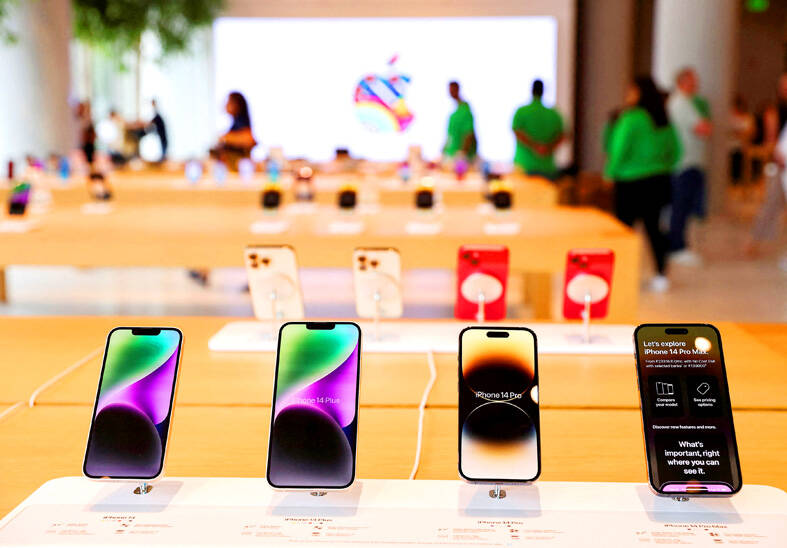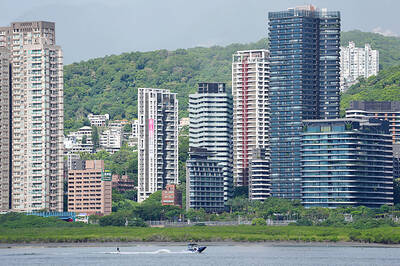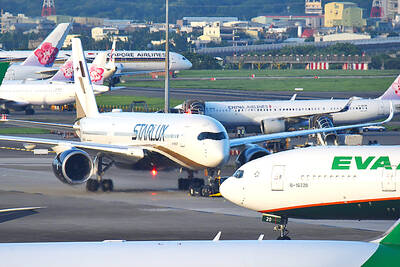Apple Inc assembled US$22 billion worth of iPhones in India in the 12 months ended last month, increasing production by nearly 60 percent over the previous year in a sign of continued diversification away from China.
The Cupertino, California-headquartered company now makes 20 percent, or one in five, of its prized iPhones in the South Asian country, people familiar with the matter said.
The dollar figure represents the devices’ estimated factory gate value, rather than the marked-up retail price.

Photo: Reuters
The ramp-up suggests the iPhone maker and its suppliers are accelerating a pivot to India from China. The bulk of India-made iPhones are assembled at Foxconn Technology Group’s (富士康) factory in southern India. Tata Group’s electronics manufacturing arm, which bought Wistron Corp (緯創) and controls Pegatron Corp’s (和碩) operations, is also a key supplier.
Of the total India production, Apple exported 1.5 trillion rupees (US$17.42 billion) in iPhones from the region in the fiscal year through last month, Indian Minister of Railways, Information and Broadcasting, and Electronics and Information Technology Ashwini Vaishnaw said on Tuesday last week.
Shipments of iPhones from India to the US accelerated after US President Donald Trump announced plans for “reciprocal” tariffs in February, the people said.
Apple’s average India production and exports surged all through the fiscal year to last month.
The Trump administration late on Friday exempted electronics goods including smartphones and computers from its reciprocal tariffs. That is good news for companies such as Apple and Nvidia Corp, although the reprieve does not appear to extend to Trump’s separate 20 percent duty on China, applied to pressure Beijing to crack down on fentanyl.
That also means iPhones made in India would not attract any duties as of now. Barring the exceptions made on Friday, Trump’s cumulative levies on China remain at 145 percent, and would likely force companies such as Apple to intensify their supply chain shift.
However, with nearly 200 suppliers and an overwhelming reliance on China, moves to other countries could take years to play out. Despite Trump’s ambition to have iPhones made in the US, Apple is unlikely to move production there any time soon due to factors including a shortage of facilities and labor needed to produce the devices.
Apple now assembles its entire iPhone range in India, including the more expensive titanium Pro models. Its manufacturing success in the world’s most populous nation is also helped by state subsidies tied to Indian Prime Minister Narendra Modi’s ambition to turn the country into a manufacturing hub.
Modi is also seeking to widen electronics component manufacturing with US$2.7 billion in new financial incentives, and is focused on advancing its semiconductor ambitions.
Apple has a nearly 8 percent market share in India’s smartphone market, where its sales — a bulk of those from iPhones — reached almost US$8 billion in fiscal 2024.

RECYCLE: Taiwan would aid manufacturers in refining rare earths from discarded appliances, which would fit the nation’s circular economy goals, minister Kung said Taiwan would work with the US and Japan on a proposed cooperation initiative in response to Beijing’s newly announced rare earth export curbs, Minister of Economic Affairs Kung Ming-hsin (龔明鑫) said yesterday. China last week announced new restrictions requiring companies to obtain export licenses if their products contain more than 0.1 percent of Chinese-origin rare earths by value. US Secretary of the Treasury Scott Bessent on Wednesday responded by saying that Beijing was “unreliable” in its rare earths exports, adding that the US would “neither be commanded, nor controlled” by China, several media outlets reported. Japanese Minister of Finance Katsunobu Kato yesterday also

Taiwan’s rapidly aging population is fueling a sharp increase in homes occupied solely by elderly people, a trend that is reshaping the nation’s housing market and social fabric, real-estate brokers said yesterday. About 850,000 residences were occupied by elderly people in the first quarter, including 655,000 that housed only one resident, the Ministry of the Interior said. The figures have nearly doubled from a decade earlier, Great Home Realty Co (大家房屋) said, as people aged 65 and older now make up 20.8 percent of the population. “The so-called silver tsunami represents more than just a demographic shift — it could fundamentally redefine the

China Airlines Ltd (CAL, 中華航空) said it expects peak season effects in the fourth quarter to continue to boost demand for passenger flights and cargo services, after reporting its second-highest-ever September sales on Monday. The carrier said it posted NT$15.88 billion (US$517 million) in consolidated sales last month, trailing only September last year’s NT$16.01 billion. Last month, CAL generated NT$8.77 billion from its passenger flights and NT$5.37 billion from cargo services, it said. In the first nine months of this year, the carrier posted NT$154.93 billion in cumulative sales, up 2.62 percent from a year earlier, marking the second-highest level for the January-September

‘DRAMATIC AND POSITIVE’: AI growth would be better than it previously forecast and would stay robust even if the Chinese market became inaccessible for customers, it said Taiwan Semiconductor Manufacturing Co (TSMC, 台積電) yesterday raised its full-year revenue growth outlook after posting record profit for last quarter, despite growing market concern about an artificial intelligence (AI) bubble. The company said it expects revenue to expand about 35 percent year-on-year, driven mainly by faster-than-expected demand for leading-edge chips for AI applications. The world’s biggest contract chipmaker in July projected that revenue this year would expand about 30 percent in US dollar terms. The company also slightly hiked its capital expenditure for this year to US$40 billion to US$42 billion, compared with US$38 billion to US$42 billion it set previously. “AI demand actually